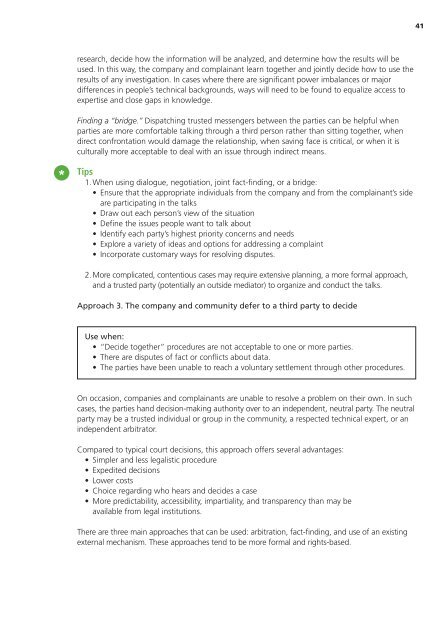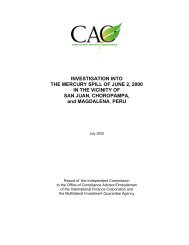A Guide to Designing and Implementing Grievance Mechanisms for ...
A Guide to Designing and Implementing Grievance Mechanisms for ...
A Guide to Designing and Implementing Grievance Mechanisms for ...
Create successful ePaper yourself
Turn your PDF publications into a flip-book with our unique Google optimized e-Paper software.
*<br />
research, decide how the in<strong>for</strong>mation will be analyzed, <strong>and</strong> determine how the results will be<br />
used. In this way, the company <strong>and</strong> complainant learn <strong>to</strong>gether <strong>and</strong> jointly decide how <strong>to</strong> use the<br />
results of any investigation. In cases where there are significant power imbalances or major<br />
differences in people’s technical backgrounds, ways will need <strong>to</strong> be found <strong>to</strong> equalize access <strong>to</strong><br />
expertise <strong>and</strong> close gaps in knowledge.<br />
Finding a “bridge.” Dispatching trusted messengers between the parties can be helpful when<br />
parties are more com<strong>for</strong>table talking through a third person rather than sitting <strong>to</strong>gether, when<br />
direct confrontation would damage the relationship, when saving face is critical, or when it is<br />
culturally more acceptable <strong>to</strong> deal with an issue through indirect means.<br />
Tips<br />
1.When using dialogue, negotiation, joint fact-finding, or a bridge:<br />
• Ensure that the appropriate individuals from the company <strong>and</strong> from the complainant’s side<br />
are participating in the talks<br />
• Draw out each person’s view of the situation<br />
• Define the issues people want <strong>to</strong> talk about<br />
• Identify each party’s highest priority concerns <strong>and</strong> needs<br />
• Explore a variety of ideas <strong>and</strong> options <strong>for</strong> addressing a complaint<br />
• Incorporate cus<strong>to</strong>mary ways <strong>for</strong> resolving disputes.<br />
2.More complicated, contentious cases may require extensive planning, a more <strong>for</strong>mal approach,<br />
<strong>and</strong> a trusted party (potentially an outside media<strong>to</strong>r) <strong>to</strong> organize <strong>and</strong> conduct the talks.<br />
Approach 3. The company <strong>and</strong> community defer <strong>to</strong> a third party <strong>to</strong> decide<br />
Use when:<br />
• “Decide <strong>to</strong>gether” procedures are not acceptable <strong>to</strong> one or more parties.<br />
• There are disputes of fact or conflicts about data.<br />
• The parties have been unable <strong>to</strong> reach a voluntary settlement through other procedures.<br />
On occasion, companies <strong>and</strong> complainants are unable <strong>to</strong> resolve a problem on their own. In such<br />
cases, the parties h<strong>and</strong> decision-making authority over <strong>to</strong> an independent, neutral party. The neutral<br />
party may be a trusted individual or group in the community, a respected technical expert, or an<br />
independent arbitra<strong>to</strong>r.<br />
Compared <strong>to</strong> typical court decisions, this approach offers several advantages:<br />
• Simpler <strong>and</strong> less legalistic procedure<br />
• Expedited decisions<br />
• Lower costs<br />
• Choice regarding who hears <strong>and</strong> decides a case<br />
• More predictability, accessibility, impartiality, <strong>and</strong> transparency than may be<br />
available from legal institutions.<br />
There are three main approaches that can be used: arbitration, fact-finding, <strong>and</strong> use of an existing<br />
external mechanism. These approaches tend <strong>to</strong> be more <strong>for</strong>mal <strong>and</strong> rights-based.<br />
41





